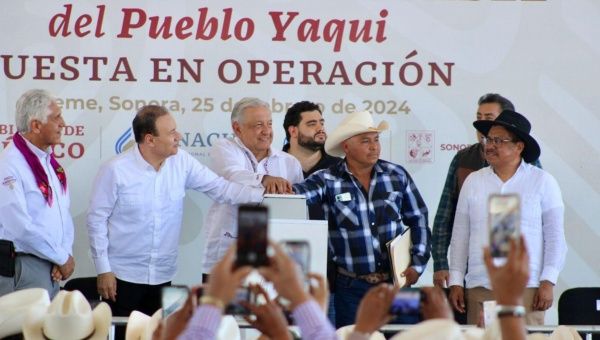SONORA (Mexico), Feb 26 (NNN-TELESUR) — More than 40,000 indigenous people in the northern state of Sonora will have access to drinking water with the Yaqui Aqueduct, inhabitants of 50 communities that have faced shortages for years.
The Mexican President, Andrés Manuel López Obrador, inaugurated on Sunday the Yaqui Aqueduct, a water work that solves the serious water shortage in 50 rural communities, populated by 40,000 indigenous people, who live south of Sonora, in northwestern Mexico.
López Obrador recalled that the Yaqui Aqueduct is part of the commitments of the Justice Plan for Indigenous Peoples that seeks to compensate the historical demands of the Yaqui Nation that include education, health, social development, economy, water supply and territory.
“We calculate that with this aqueduct, the pump, water-purification plants and its branches, enough to supply the indigenous communities in the next 30 years, even with their population growth, so it is an important work, supplemented with the recovery of the land that was taken from them for the benefit of the Yaqui people,” he said.
Alfonso Durazo Montaño, governor of Sonora recognized that there are hundreds of indigenous families without access to drinking water, despite the former Mexican president Lázaro Cárdenas (1934-1940) published in his government a decree that provided water to the Yaquis communities.
Durazo explained that the Yaqui Aqueduct is 166 kilometers long with 75 kilometers of branches to connect to the 50 communities that make up the Eight Towns -Loma de Guamúchil, Loma de Bácum, Tórim, Vicam, Pótam, Ráhum, Huirivis and Belem- those make up the indigenous nation, where 40,000 people live.
The work transfers water from the basin of the Yaqui River, from which four cities of Sonora are supplied, including Hermosillo, capital of the state; Obregón City; Guaymas and Empalme, where more than 1.5 million inhabitants live, while the indigenous living in the Eight Yaqui Peoples suffered from shortages.
Because the Yaqui Nation has agricultural and coastal areas, the inhabitants of the Eight Indigenous Peoples were supplied with wells, many of which are dry, killed or contaminated with saltpeter from the sea or heavy metals from agricultural inputs used in the Yaqui Valley. — NNN-TELESUR







